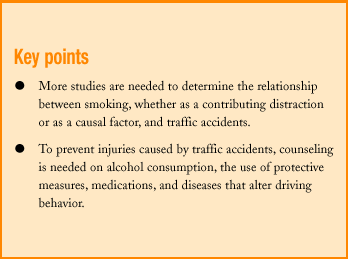Traffic accidents are an important health problem because of their associated morbidity and mortality, and because of the disabilities they cause. In 2001,1 traffic accidents accounted for 4145 deaths in Spain. Some authors have found that close to 9% of the over-15 population in Spain has been involved in traffic accidents.
This is a problem that particularly affects young people: it is the most frequent cause of death among children and adults of both sexes aged 5 to 24 years, the second most frequent cause in men and women aged 25 to 34 years and in men aged 35 to 44 years, and the third most frequent cause of death among women aged de 35 to 44 years.2
Recent guidelines3,4 identify three main risk groups: the 15-to-24-year-old population of users of two-wheeled vehicles, the 18-to-34-year-old population of occupants of cars on the road, and pedestrians aged more than 65 years in urban areas.
The following risk factors (among others) have been identified in relation with the frequency and seriousness of traffic accidents:
1. Improper use or nonuse of safety measures (seat belts, helmets, car seats).
2. Drinking.
3. Use of medications that alter driving capacity (anxiolytics, antidepressants, antiepileptics, cardiovascular therapy, etc.).
4. Certain diseases that also alter driving capacity (sleep apnea, visual or auditory defects, diabetes, epilepsy, etc.).
The authors of the article «Smoking and nonfatal traffic accidents» emphasize the relationship between smoking and higher accident rates. They conclude, appropriately, that because of the nature of their study, they cannot claim a direct relationship between smoking and accidents.
Research on this relationship has given rise to different and at times contradictory results. For example, Guibert et al,5 in a case-control study that compared a group of 2504 drivers involved in accidents and 2520 drivers with no history of accidents, found no relationship between smoking and involvement in traffic accidents. However, Brison,6 in a similar study, found that smokers were 1.5 times as likely as nonsmokers to have accidents. According to this author, the basis for this association may be distraction of the driver by smoking, differences in behavior between smokers and nonsmokers, and carbon monoxide toxicity.
Different reviews of the subject7 have noted factors that affect driver attentiveness, and indicate that the most important distractions are use of cell phones, electronic aids (navigation systems) and information and entertainment systems (radios, etc.).
Two lines of research that are therefore likely to be of interest are smoking as a distraction, and as a risk factor for having an accident or worsening the prognosis of accidents. Further studies like the one in this issue of Atención Primaria will undoubtedly be needed to confirm the findings in our setting, and advances are most likely to come from studies based on prospective cohort and experimental designs.
On a final note, the need for better preventive interventions aimed at alcohol consumption, undoubtedly the most important and best-studied factor to date, must be emphasized.









